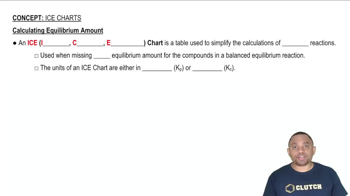Calculate the equilibrium concentrations of H2O(g), Cl2(g), HCl(g), and O2(g) at 298 K if the initial concentrations are [H2O] = 0.050 M and [Cl2] = 0.100 M. The equilibrium constant Kc for the reaction H2O(g) + Cl2(g) ⇌ 2 HCl(g) + O2(g) is 8.96 × 10^-9 at 298 K.
 Verified step by step guidance
Verified step by step guidanceKey Concepts
Chemical Equilibrium

Equilibrium Constant (Kc)

ICE Table (Initial, Change, Equilibrium)

Consider the following equilibrium: Ag+ (aq) + Cl-(aq) → AgCl(s) Use Le Châtelier's principle to predict how the amount of solid silver chloride will change when the equilibrium is disturbed by: (a) Adding NaCl (b) Adding AgNO3
Consider the following equilibrium: Ag+ (aq) + Cl-(aq) → AgCl(s) Use Le Châtelier's principle to predict how the amount of solid silver chloride will change when the equilibrium is disturbed by: (c) Adding NO3, which reacts with Ag+ to form the complex ion Ag(NH3)2+
Consider the following equilibrium: Ag+(aq) + Cl-(aq) ⇌ AgCl(s) Use Le Châtelier's principle to predict how the amount of solid silver chloride will change when the equilibrium is disturbed by: (d) Removing Cl-; also account for the change using the reaction quotient Qc
